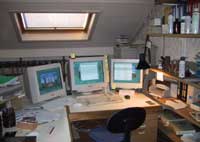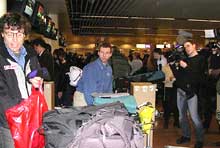|
|
|
After having completed the final tests - which were conclusive - of the satellite links, the team is due to leave for Tiksi this morning, and fly directly towards the starting point. We will probably find out more about this during the day. As far as the daily (or nearly) updates of the adventure will work, the duo has already told us that during the first weeks of progress, in other words during a period when there are only approximately three hours of light each day, the links with HQ will be kept to a minimum.
That is to save the batteries, of course. They can only recharge
the batteries using a few solar panels carried in their baggage
once the sun is higher in the sky. Which means that there will not
be any photos, and only one or two minutes of satellite phone contact
per day.
Everything
arrived safely at Khatanga (equipment and men) and the team is carrying
out the final testing of the satellite links. In fact, they are
making the most of the time it takes to send the flight authorisations
from Moscow to Tiksi. These are needed because it is a military
flight. When
they take off for Tiksi, they will be overflying their starting
point (it seems that, despite temperatures out of a different world
(-50°C excluding wind chill), there is quite a lot of open water
around the archipelago) and will parachute in the kerosene required
(the stockpile delivered last year has disappeared) for the return
flight of the MI8 helicopter to Tiksi once they have been dropped
off finally at Kotelny, one of the New Siberian Islands.
Below
are a few useful Web addresses that will help you to find out more
about these places at the ends of the earth.
(See also our picture gallery (20 photos) for which the photos were taken by Alain and Dixie during their respective training trips to northern Siberia.
Family,
some friends and journalists, a few cameras and microphones: just
fifty or so well-wishers (in any case fewer than when they left for
the Antarctic 4 years ago) made the trip despite the early hour to
see off the Compaq Pole II expedition. Going
with them is the French photographer from Chamonix, René Robert,
a renowned specialist for photographing adventures and master in difficult
shooting conditions. He was the photographer selected by Alain Hubert
to go with him on his The Wall in Antarctica expedition. The shots
taken by René Robert were simply superb. This time around,
his job will be to use the three hours or so of pallid light that
glimmer in the far Siberian north at this time of the year - light
from the ends of the earth, you might say - to record the expedition
on film. "I also can't wait to photograph the Northern Lights,"
Robert told us. "It's a real challenge for photographers."
. The
whole team will stop over in Moscow for two days before flying to
Khatanga on 13th February. From there, they will board an Antonov
74 for Tiksi before being flown out to the islands of New Siberia
in a big Russian MI8 helicopter.
Back
from the press conference held last week in St Petersburg (see
photos), Dixie Dansercoer explains the main points of his physical
preparation programme that he began 21 months ago with the assistance
of Frank De Witte, who is part of the Belgian Olympic Committee (the
same coach who handles Alain Hubert). He
also talks about the methods he uses for his mental training (highly
unusual), which he feels is responsible for 80% of the success of
his adventures. He
also tells us about the
Today,
the Compaq Pole II expedition is holding a press conference for some
thirty or so Belgian and French journalists who have been invited to
St Petersburg by our expedition partner, Compaq.
We
will return in detail during the course of the expedition to certain
aspects of the work that goes into preparing for an adventure of this
scale - and in particular the physical preparation that is so important
in this type of challenge. Between now and the beginning of next week,
we will also be publishing an interview on this topic that we conducted
with Dansercoer and Frank De Witte, who has been responsible for the
physical preparation of the two men. These facets of the trip may be a little on the technical side, but in view of the many specific details (rigidity, weight, buoyancy, etc.) that the designers had to contend with, it is extremely interesting to follow some of the stages involved in manufacturing the sledges and to see how a small Belgian company - Aériane - was able to come up with the right product for our two men. By
clicking on the windows opposite, you will find the specifications used
for the sledges, details about how their shape was designed, an analysis
of the composite materials used and information about the trials conducted
in a cold storage room and in situ out in northern Siberia barely two
month ago. You'll also find dimensions, plus all of the technical specifications
for the sledges. There is also a profile of the small Belgian company
that built them.
|




 We've
been busy surfing the Net for you and have browsed our way through
encyclopaedias to find out more about the towns of Khatanga and
Tiksi through which the Compaq Pole II team is due to pass. In fact,
they arrived in Khatanga yesterday evening and are due to take another
plane today for Tiksi (
We've
been busy surfing the Net for you and have browsed our way through
encyclopaedias to find out more about the towns of Khatanga and
Tiksi through which the Compaq Pole II team is due to pass. In fact,
they arrived in Khatanga yesterday evening and are due to take another
plane today for Tiksi (



 contacts
he has had with some of the inmatesat Leuven prison, whose inner strength
he has drawn on during his encounters with them; he explains the type
of music he will be taking with him in his sledge (Andreas Vollenweider,
especially, seen here in the photo), and gives details of the talks
he has had with his children about his forthcoming long absence. He
also talks about some of the keys for the expedition's success.
contacts
he has had with some of the inmatesat Leuven prison, whose inner strength
he has drawn on during his encounters with them; he explains the type
of music he will be taking with him in his sledge (Andreas Vollenweider,
especially, seen here in the photo), and gives details of the talks
he has had with his children about his forthcoming long absence. He
also talks about some of the keys for the expedition's success.